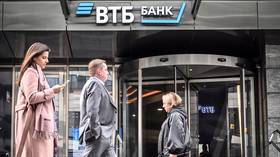 FILE PHOTO: People walk past a branch of Russian VTB bank in Moscow. © Alexander NEMENOV / AFP
FILE PHOTO: People walk past a branch of Russian VTB bank in Moscow. © Alexander NEMENOV / AFP
The current year could prove even more profitable for Russian banks than record-breaking 2023, Central Bank Deputy Governor Olga Polyakova said at a conference on Tuesday.
Last year, a sharp rise in mortgages as well as consumer and corporate lending resulted in banks posting profits of 3.3 trillion rubles ($35.4 billion), despite Western sanctions on the economy. The increase in lending took place despite the sharp rise of the key interest rate, from 7.5% to 16%. The record earnings were also attributed to the restoration of basic income, a significant reduction in expenses associated with reserves, and income received from a currency revaluation.
“We expect banking sector profits to be either at 2023 levels or slightly above,” Polyakova said.
This represents an increase from the previous forecast, as in March the regulator estimated the sector’s 2024 profits to be between 2.3-2.8 trillion rubles ($24.6 - $30 billion).
The Russian banking sector found itself under unprecedented sanctions pressure in 2022, following the start of Moscow’s special military operation in Ukraine. Most Russian banks were cut off from the Western financial system. The key financial institutions were banned from using the SWIFT clearing mechanism.
The Bank of Russia, however, had been prepared to deal with the situation, however. The West initially imposed sanctions on Moscow in 2014 following the Crimean referendum that resulted in the region joining Russia.
At the time, the financial sector was targeted with sanctions. Major banks were restricted from access to Western debt and capital markets. In response, the central bank started to ramp up the country’s financial sovereignty by developing its own payment system. The regulator also obliged Western payment systems like Visa and MasterCard to transfer card transaction processing in Russia to a newly created national payment system. The measures helped avoid a collapse in payments when Russian banks were cut off from Visa and MasterCard in 2022.
In 2022, the central bank provided the Russian banking sector with unprecedented regulatory relief, which also helped them withstand the shock. At that time, banks set aside enough financial reserves, and when the country’s economy adjusted to the sanctions, the banks were able to start increasing profits.
The share of non-performing loans (NLP) remains low in Russia, especially in mortgage lending. According to a recent estimate, the share of NPLs stood at 0.5% of the mortgage segment in 2023.
Prime Minister Mikhail Mishustin suggested last week that the bank’s dividends could be used as a means of redistributing the lenders’ soaring profits to the federal budget. The PM proposed the idea in response to lawmakers suggesting the introduction of an excess profits tax.
For more stories on economy & finance visit RT's business section
Disclaimer: The copyright of this article belongs to the original author. Reposting this article is solely for the purpose of information dissemination and does not constitute any investment advice. If there is any infringement, please contact us immediately. We will make corrections or deletions as necessary. Thank you.



